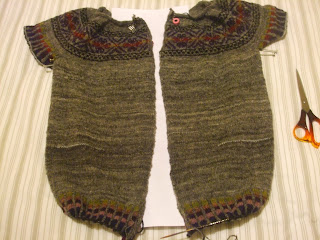The design is by Kate Davies, from her book Colours of Shetland.
Kate designed it to be kntted in Jamieson & Smith's Shetland wool yarn, but I decided to spin and dye the yarn for my version myself.
First I selected the fleeces, a naturally grey Blue Texel for the main colour, and a black Zwartbles for the first contrast, both from sheep raised within 5km of my home. The other contrast colours were Shetland wool and some Italian Bose tops, all dyed in solar jars on my windowsill.
The dyes I used were Logwood (two different strengths), Logwood and Madder mixed, beetroot, and silver birch overdyed with Japanese indigo for the yellowy green). I also dyed two lighter pinky-purple shades, one with Lac, but eventually I did not use these in the finished tunic.
The Blue Texel fleece was a mixture of grey shades,
and I carded and blended it repeatedly using a drum carder to try to get a more even shade. Then I spun it into 11 skeins of 2-ply yarn 14 wraps per inch
I spun four skeins of the Zwartbles, and one skein each of seven dyed colours, over the summer, mostly while demonstrating spinning at local Highland Games and agricultural shows. The black Zwartbles and the darker purples were easier to see outside in daylight.
I didn't start knitting until all the colours were spun, as I needed them straight away in the bottom welt.
The tunic was knitted entirely in the round, then I cut the steek to make the front opening.
 |
| Steek reinforced with crochet before cutting |
The only modification I made to the design was to add pockets with a corrugated rib edging.
Once the neck and button bands were finished I decided to replace the bottom welt. I had originally used two different shades in it but now I knew that I had enough of the 'proper' colours, so I boldly cut the welt away, picked up the stitches and knitted it again.
The whole garment is edged with knitted-on I-cord, a daunting prospect but it went quicker than I expected, as there was always a corner to aim for. It gives a really nice finish, well worth the effort.
Instead of making woollen buttons as described in Kate's instructions I used some amazing buttons I had found in an antiques market in Lucca.
It has been a long time in the making - I've actually knitted a few other small projects at the same time - but now that the winter weather has arrived I'm very glad to be wearing my cosy Scatness tunic! I'm spinning wool from lots of different breeds of sheep for my next handspun project, and today I was out taking photos to use in the design of the one after that. Watch this space.....!












bellissimo Deborah e che grande lavoro per tutto! grande soddisfazione alla fine!
ReplyDeleteIt has turned out beautifully! Such a lot of work went into this. I hope you get lots of satisfaction when you wear this gorgeous tunic - it is outstanding.
ReplyDeleteOur friend, Bev, recommended your blog. I don't know what to say other than, WOW. This is an incredible work of art. I am so glad she introduced me to you... Thank you for sharing.
ReplyDeleteCiao Deborah....e' splendido...che lavoro impegnativo........ma ...sai che non capisco l'inglese.....l'hai TAGLIATO?????? ......spero da te non ci siano stati danni per il tempo, ho visto in televisione che la Scozia e' stata attraversata da una brutta tempesta....un abbraccio Loredana
ReplyDeleteThis is really lovely. Well done.
ReplyDeleteabsolutely gorgeous!
ReplyDeleteVery lovely. Well done for plant dyeing those lovely colours. I'm intrigued to see how they weather. People keep telling me how much mine will fade, but they don't seem to much! Yes, you give me hope, as I am spinning and knitting a jumper, but I sometimes feel the prepping and spinning will never end....only one arm to go! Thank goodness for those short projects that keep us going...
ReplyDeleteWhat a fantastic project! You must send a link to Kate Davies and show her what you have made!
ReplyDeleteYour tunic turned out beautiful!! I like your dyed yarn and the pockets. I just started my tunic (way to go!) and maybe I'll adopt those pockets. Really, really gorgeous.
ReplyDelete